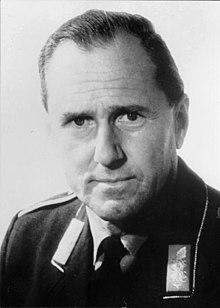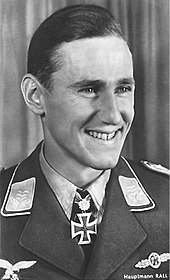Günther Rall
Günther Rall (born March 10, 1918 in Gaggenau , † October 4, 2009 in Bad Reichenhall ) was a German officer, most recently lieutenant general in the Federal Air Force. In the Second World War he was a fighter pilot and highly decorated. In 1970 he was the commanding general of the Air Fleet Command , from 1971 to 1974 inspector of the air force and 1974/75 German representative in the NATO military committee .
Life
Childhood and adolescence
Rall grew up in Gaggenau together with his older sister Lotte in a conservative-Protestant family home. At that time, his father was an authorized signatory at Eisenwerke Gaggenau AG . After moving to Stuttgart , Rudolf Rall was an independent businessman. He was also a member of the "Stahlhelm" and was - "at heart monarchist " - close to the DNVP . Günther Ralls mother Minna was very involved in church life and raised her children accordingly. Günther Rall attended the humanist -oriented Karls-Gymnasium in Stuttgart before he switched to Napola Backnang in 1935 , where he graduated from high school the following year.
Military career
Wehrmacht

After completing the Reich Labor Service , he joined the Army in the 13th Infantry Regiment on December 4, 1936 as an officer candidate . On 1 July 1938 he joined as a midshipman on the Air Force , where he after completing his training as a fighter pilot as Lieutenant the fighter squadron 52 was assigned. In this squadron he was to spend most of the Second World War . He won his first aerial victory on May 18, 1940 near Metz . This was to be followed by 274 more confirmed aerial victories in the course of the war. In 1941 the squadron was used in the fighting in Crete and in Operation Barbarossa . After he was shot down in November 1941, he had to be treated for a serious back injury at the Vienna University Hospital until July 1942. There he met his future wife. He returned to his squadron and became one of the Air Force's most successful fighter pilots. Because of his successes he was stylized by propaganda as an idol and received high awards. These facts helped him to survive legal proceedings against himself in 1943 (his future wife had helped several Jewish citizens to leave Vienna in 1938 after the annexation of Austria ).
In April 1944, now with the rank of major and with 273 aerial victories at that time the most successful fighter pilot in the Luftwaffe, he was ordered to defend the Reich in the west, where he was group commander in JG 11. On May 12, 1944, it was shot down immediately after its 275th and final victory in the air. He struggled with a severe wound infection for several months. In November 1944 he became the commander of the General of the Fighter Pilot's Association Driving School . In the last two months of the war, he led the JG 300 as a commodore . At the surrender he was taken prisoner of war , from which he was released in August 1945. Then Rall initially worked as a manager in the deforestation of forests in southwest Germany (this had become necessary due to a bark beetle plague ). He later took up a job at Siemens & Halske . His wife initially worked as a doctor in a children's hospital, later in the Schloss Salem boarding school (Baden); Rall himself was also employed there at times.
armed forces
With effect from January 1, 1956, Rall was taken over as a major in the Bundeswehr. From September 1956 to March 1957 he received training on the North American T-6 and the jet-powered Lockheed T-33 . This was followed at the end of 1958 by instruction on the F-104 Starfighter , for which he was the first German pilot to acquire the license. He was then able to use his experience as a stage manager for fighter pilots in the General Air Force Office and as head of the F-104 task force. After attending a course at the NATO Defense College in Paris in 1964 and his last active aviation assignment as 2nd commodore of JaboG 34 in Memmingen from 1964 to 1966, he was employed in various command authorities:
- 1966/67: Stage manager "Air Force Flying Units" in the Air Force Office , Cologne-Wahn
- 1967/68: Commander 3rd Air Force Division , Kalkar
- 1968/69: Commander of the 1st Air Force Division, Meßstetten
- 1969/70: Chief of Staff of the 2nd Allied Tactical Air Force (ATAF) , Rheindahlen
- 1970: Commanding General Luftflotte , Cologne-Wahn
- 1971–1974: Inspector of the Air Force , Bonn
- 1974–1975: German Military Plenipotentiary in the NATO Military Committee , Brussels
After Rall had already come under public criticism because of the accidents with the " Starfighter " that fell during his term of office, another affair on the occasion of a trip to South Africa at the end of 1974 led to his resignation: Rall traveled under a false name and Costs of the South African government in the country that was internationally criticized for the apartheid ruling there . In South Africa, Rall visited the Pelindaba nuclear research center , spoke to South African generals and toured military facilities. The official reason for the trip was the visit of a former comrade living in what is now Namibia . On October 1, 1975, Federal Defense Minister Georg Leber Rall dismissed . The big tattoo , which is common when leaving, was omitted, also because the SPD parliamentary group had announced that it would stay away from the tattoo, whereupon Rall himself asked for the event to be canceled. He himself also emphasized in his memoirs that the visit had a purely private background and that he had come into contact with the South African military without any action on his part; However, he does not list individual visits to certain facilities.
Rall remained connected to the Air Force even after his active service. In 2004/05, he and other former air force generals campaigned against the withdrawal of the traditional name “ Mölders ” from Jagdgeschwader 74 , which he had given the squadron during his time as inspector of the air force. The traditional name was withdrawn by the Minister of Defense in January 2005 .
Awards
- Trophy of honor for special achievement in air warfare
- Iron Cross (1939) 2nd and 1st class
- Wound badge (1939) in gold
- German cross in gold
- Cuff bracelet Crete
-
Knight's Cross of the Iron Cross with oak leaves and swords
- Knight's Cross September 3, 1942 (on the occasion of the 65th aerial victory)
- Eichenlaub October 26, 1942 (134th award on the occasion of the 100th aerial victory)
- Swords September 12, 1943 (34th award on the occasion of the 200th aerial victory)
- Front flight clasp for hunters in gold with tag, mission number "600"
- twice mentioned in the Wehrmacht report
- "Honorary Fellow" of the Society of Experimental Test Pilots (SETP)
- Legion of Merit (USA)
- Federal Cross of Merit (1973)
- Large Federal Cross of Merit with a star
plant
- Günther Rall: My flight log. Memories 1938–2004 . Twenty-nine six, Moosburg 2004, ISBN 978-3-9807935-3-7
Private

During the fighting, Rall was seriously wounded four times and spent a total of 15 months in the hospital. During a long hospital stay in Vienna in 1941/42, he was treated by the doctor Hertha Schön, whom he married in 1943. This marriage resulted in four children, two of whom died as infants. Günther Rall was widowed on July 4, 1985. He died of a heart attack.
He last lived in Bad Reichenhall .
See also
- List of German fighter pilots in World War II
- List of bearers of the Knight's Cross of the Iron Cross of Fighter Pilots
- List of bearers of oak leaves for the Knight's Cross of the Iron Cross
- List of bearers of oak leaves with swords for the Knight's Cross of the Iron Cross
- History of the Bundeswehr
- Luftwaffe (Bundeswehr) #History
Web links
- Literature by and about Günther Rall in the catalog of the German National Library
- Profile and detailed biography
- Portrait on der-deutsche-jagdflieger.de
- military short biography (English)
- Wall Street Journal obituary
- Obituary from the Daily Telegraph
Individual evidence
- ↑ Günther Rall died
- ↑ This is how G. Rall characterizes his father in Mein Flugbuch , p. 17.
- ↑ Joachim Käppner , Kurt Kister : Flying hero Günther Rall about heroism. (No longer available online.) In: Süddeutsche Zeitung . April 5, 2009, archived from the original on September 1, 2009 ; accessed on March 16, 2016 (interview).
- ↑ 25 Luftwaffe aircraft fought against 900 heavy bombers of the US Air Force , protected by 800 fighters ( document: interview )
- ↑ a b Lieutenant General Günther Rall. Inspector of the Air Force from 1971 to 1974. In: History of the Air Force. Federal Ministry of Defense, July 13, 2015, accessed on March 16, 2016 .
- ↑ Avoid publicity . In: Der Spiegel . No. 41 , 1975, p. 27-30 ( online ). The Leber case: four dispatches, one denial . In: Der Spiegel . No. 43 , 1975, p. 23-25 ( online ).
- ^ Rall: My flight log. 2004, p. 322.
- ^ Rall: My flight log. 2004, pp. 319-321.
| personal data | |
|---|---|
| SURNAME | Rall, Günther |
| BRIEF DESCRIPTION | German Lieutenant General, Inspector of the Federal Air Force, fighter pilot in WWII |
| DATE OF BIRTH | March 10, 1918 |
| PLACE OF BIRTH | Gaggenau |
| DATE OF DEATH | 4th October 2009 |
| Place of death | Bad Reichenhall |


